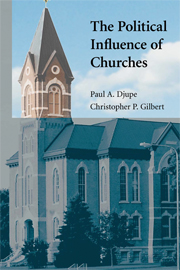Book contents
- Frontmatter
- Contents
- Acknowledgments
- Introduction: A Theory of Religious Influence on Political Behavior
- 1 Social Networks and Church Structure
- 2 Clergy Influences and Religious Commitment Reconsidered
- 3 Church-Centered Influences on Public Opinion
- 4 The Resourceful Believer
- 5 The Construction of Political Mobilization in Churches
- 6 Present but Not Accounted for?
- 7 Conclusion
- Appendix: Variable Coding
- References
- Index
1 - Social Networks and Church Structure
Congregations, Small Groups, Informal Contacts
Published online by Cambridge University Press: 05 June 2012
- Frontmatter
- Contents
- Acknowledgments
- Introduction: A Theory of Religious Influence on Political Behavior
- 1 Social Networks and Church Structure
- 2 Clergy Influences and Religious Commitment Reconsidered
- 3 Church-Centered Influences on Public Opinion
- 4 The Resourceful Believer
- 5 The Construction of Political Mobilization in Churches
- 6 Present but Not Accounted for?
- 7 Conclusion
- Appendix: Variable Coding
- References
- Index
Summary
any theory claiming to evaluate the political influence of churches must begin with a detailed discussion of how churches are organized. In this chapter we will introduce and empirically describe several basic characteristics of congregational organization, focusing specifically on the conduits through which political information flows among church members. The chapter opens by describing the methods used to gather the data we will analyze throughout the book, discussing why we have chosen the ELCA and Episcopal Church to conduct our analysis, and summarizing the unique types of information gathered from our survey respondents. The remainder of this chapter begins to bring to life our theoretical framework of congregational organization as we map the social structure of our sample congregations, focusing principally on political orientations within the entire church and also within church social networks, thus providing empirical evidence for the extent and nature of the church-centered information pathways that lead to political influence.
Congregations large and small are typically diverse organizations across an array of social and political indicators, with many points of contact for individual members and thus many ways for members to acquire knowledge about the lives and beliefs of their fellow congregants. Over time members gain a sense of the congregation as a whole, through meeting other members (typically the first point of contact when entering a new church) and eventually interacting with the clergy and professional staff.
- Type
- Chapter
- Information
- The Political Influence of Churches , pp. 21 - 57Publisher: Cambridge University PressPrint publication year: 2008



